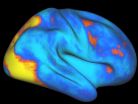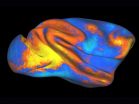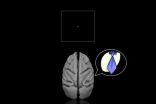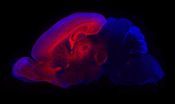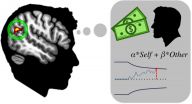"The human brain is powerful, but even it cannot make sense of the entire sum of stimuli that bombard our senses," said Vincent P. Ferrera, PhD, the study's senior author. Dr. Ferrera is a principal investigator at Columbia's Mortimer B. Zuckerman Mind Bran Behavior Institute and associate professor in the department of neuroscience (in psychiatry) at CUMC. "Instead, it selects and prioritizes information based on what is needed at any given moment--this is called attention. And while attention is a fundamental characteristic of human cognition, and something that we use all the time, the underlying brain circuits that give us this ability remain largely unclear."
In order to better understand these circuits, the authors compared the brains of primate and human subjects during a specific attention-seeking task. In so doing, they uncovered key clues about these so-called 'attention networks': how they evolved and how they underlie human cognitive abilities--and are already using this information to test what role they may play in psychiatric disorders.
In the human brain, there are two main attention networks: the dorsal attention network (DAN) and ventral attention network (VAN). "The DAN is in charge of directing your attention to something specific, and when it's active, the VAN is silent," explained Gaurav Patel, MD/PhD, a postdoctoral fellow in the Department of Psychiatry and the study's first author. "This keeps you focused and limits your distraction. But if you see something that is new, unique, or behaviorally relevant, the VAN will switch on. This give-and-take between the DAN and VAN allows us to reorient our attention to what is most important."
In a series of experiments, first using a primate model at Washington University in St. Louis, and later with human subjects at CUMC, the researchers used functional magnetic resonance imaging (fMRI) to map brain activity. Before the start of a session, the subject memorized a specific target object. During the session, a stream of images appeared on various parts of a screen. The subject pushed a button when the target object appeared on the screen. fMRI technology allowed the researchers to see when various parts of the brain 'switched on' while the subject performed the task. And the results were surprising.
"The fMRI showed striking differences between the two species, which was wholly unexpected," said Dr. Patel. "We were giving both the human and primate subjects the exact same task--their brain activity should have been more similar. That's when we realized there was something else going on."
First, they realized that the VAN--located in the right hemisphere of the human brain--had no equivalent in the primate brain. They also noticed the DAN had expanded in the human subjects, and observed enhanced cross talk between the human subjects' brain hemispheres.
"Taken together, these findings suggests that at some point in our evolutionary history, we evolved an additional attention network--perhaps in order to better process the world around us," said Dr. Patel.
The human social world is far more complex than any of our primate relatives. It is possible this network evolved to help us understand increasingly complex social cues, such as the subtle twitch of an eyebrow, or a shift in gaze, say the researchers.
Armed with this new information, Dr. Patel is now examining the attention networks of people with schizophrenia--a disorder characterized in part by poor social function.
"Persons with schizophrenia have difficulty expressing emotions, responding to social cues and often become socially isolated," said Dr. Patel. "Right now we're testing whether these individuals have an impairment to how the VAN is organized or communicates with the rest of the brain. Because if they do, we could potentially tailor a treatment strategy to mitigate that impairment, and maybe even restore some level of social communication that the patient lacked."
INFORMATION:
The paper is titled "Functional evolution of new and expanded attention networks in humans." Other scientists who participated in this research include Danica Yang (SUNY College of Optometry), Emery C. Jamerson (Columbia University), Lawrence H. Snyder (Washington University School of Medicine) and Maurizio Corbetta (Washington University School of Medicine).
This research was supported by the Levy Foundation, the American Psychiatric Foundation, the National Institute of Mental Health (MH086466-04, MH018870-25, MH102471, MH096482) and the National Eye Institute (EY012135).
The authors report no financial or other conflicts of interest.
About the Zuckerman Institute
Grasping the implications for the health of the brain, mind, and nervous system is perhaps the greatest challenge facing 21st-century science. To lead the way, Columbia University has established a comprehensive institute for the pursuit of interdisciplinary and collaborative research in brain science. Building on the University's distinguished history in the study and treatment of the brain, the Mortimer B. Zuckerman Mind Brain Behavior Institute will bring together 1,000 scientists in a single state-of-the-art engine of discovery--based at the Jerome L. Greene Science Center--now rising on the University's new Manhattanville campus. It will form the hub of an even larger collaborative network of academics stretching across all disciplines--including the arts, economics, law, and medicine--and campuses, from Columbia University Medical Center to Morningside Heights and beyond. To learn more, visit zuckermaninstitute.columbia.edu.
Columbia University Medical Center provides international leadership in basic, preclinical, and clinical research; medical and health sciences education; and patient care. The medical center trains future leaders and includes the dedicated work of many physicians, scientists, public health professionals, dentists, and nurses at the College of Physicians and Surgeons, the Mailman School of Public Health, the College of Dental Medicine, the School of Nursing, the biomedical departments of the Graduate School of Arts and Sciences, and allied research centers and institutions. Columbia University Medical Center is home to the largest medical research enterprise in New York City and State and one of the largest faculty medical practices in the Northeast. For more information, visit cumc.columbia.edu or columbiadoctors.org.
